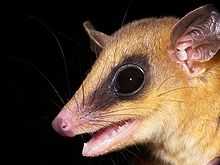Marmosa
| Mouse opossoms | |
|---|---|
 | |
| Robinson's mouse opossum (Marmosa robinsoni). | |
| Scientific classification | |
| Kingdom: | Animalia |
| Phylum: | Chordata |
| Class: | Mammalia |
| Infraclass: | Marsupialia |
| Order: | Didelphimorphia |
| Family: | Didelphidae |
| Subfamily: | Didelphinae |
| Genus: | Marmosa Gray, 1821 |
| Type species | |
| Didelphis marina Gray, 1821 | |
| Subgenera | |
| |
The nineteen species in the genus Marmosa are relatively small Neotropic members of the family Didelphidae.[1] This genus is one of three that are known as mouse opossums. The others are Thylamys (the "fat-tailed mouse opossums") and Tlacuatzin, the grayish mouse opossum. Members of the genus Marmosops used to be called "slender mouse opossums", but are now just called "slender opossums". The six members of the Marmosa subgenus Micoureus, known as "woolly mouse opossums", were formerly considered to be a separate genus,[2] but were moved into Marmosa in 2009.[3]
Mouse opossums are generally found in rainforests as they scavenge bromeliads for food.
The species in subgenus Marmosa (Gray, 1821) are:
- Marmosa andersoni
- Marmosa isthmica
- Marmosa lepida
- Marmosa mexicana
- Marmosa murina
- Marmosa quichua
- Marmosa robinsoni
- Marmosa rubra
- Marmosa simonsi
- Marmosa tyleriana
- Marmosa waterhousei
- Marmosa xerophila
- Marmosa zeledoni
The species in subgenus Micoureus (Lesson, 1842) are:
- Marmosa alstoni
- Marmosa constantiae
- Marmosa demerarae
- Marmosa paraguayanus
- Marmosa phaeus
- Marmosa regina
References
- ↑ Gardner, A. L. (2005). "Order Didelphimorphia". In Wilson, D. E.; Reeder, D. M. Mammal Species of the World (3rd ed.). Johns Hopkins University Press. pp. 8–10. ISBN 978-0-8018-8221-0. OCLC 62265494.
- ↑ Gardner, A. L. (2005). "Order Didelphimorphia". In Wilson, D. E.; Reeder, D. M. Mammal Species of the World (3rd ed.). Johns Hopkins University Press. pp. 3–18. ISBN 978-0-8018-8221-0. OCLC 62265494.
- ↑ Voss, R. S.; Jansa, S. A. (2009). "Phylogenetic relationships and classification of didelphid marsupials, an extant radiation of New World metatherian mammals". Bulletin of the American Museum of Natural History 322: 1–177. Retrieved 2012-01-18.